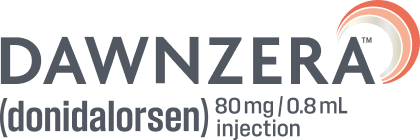

treatment? Meet DAWNZERA
DAWNZERA offers a new approach to long-term hereditary angioedema (HAE) attack prevention
See what DAWNZERA has to offer
About 90% fewer moderate-to-severe HAE attacks, HAE attacks requiring rescue medication, and HAE attacks requiring ER visits.§
About 90% fewer moderate-to-severe HAE attacks, HAE attacks requiring rescue medication, and HAE attacks requiring ER visits.§

every 4 weeks (N=45)
every 8 weeks (N=23)
(N=22)
every 4
weeks
(N=45)
every 8
weeks
(N=23)
(N=22)

All injection-site reactions were mild, nonserious, and the majority of them resolved without receiving any treatment.


